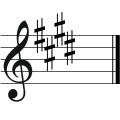E major
E major is a key of the major family of notes, based on the root note e. The key of E major is written in musical notation with four crosses (F sharp, C sharp, G sharp, D sharp). The corresponding scale and the fundamental chord of this key (the tonic e-g sharp-h) are also designated with the term E major.

![]()
![]()
![]()
![]()
![]()
![]()
![]()
![]()
![]()
![]()
![]()
![]()
![]()
![]()
![]()
E major is often described as bright and radiant, but see the article Key Character.
Key classification
| Keys and their accidentals | |||||||||||||||
| Portent: | 7 ♭ | 6 ♭ | 5 ♭ | 4 ♭ | 3 ♭ | 2 ♭ | 1 ♭ | 0 ♭/♯ | 1 ♯ | 2 ♯ | 3 ♯ | 4 ♯ | 5 ♯ | 6 ♯ | 7 ♯ |
| Major keys: | Ces | Ges | Des | As | It | B | F | C | G | D | A | E | H | F# | C sharp |
| Minor keys: | as | it | b | f | c | g | d | a | e | h | F# | cis | gis | dis | ais |
Questions and Answers
Q: What is E major?
A: E major is a major scale with a base note of E.
Q: How many sharps are in the key signature of E major?
A: E major has four sharps in its key signature.
Q: What is the relative minor of E major?
A: The relative minor of E major is C-sharp minor.
Q: What instruments is E major hard to play on?
A: E major is hard to play on wind instruments.
Q: Why is E major good for violin?
A: E major is good for violin because two of the open strings are A and E, the tonic and subdominant.
Q: When writing in E major, what type of clarinets should be used?
A: When writing in E major, clarinets in A should be used instead of clarinets in B-flat to make it easier to play.
Q: What is a famous concerto written in E major?
A: Felix Mendelssohn's Violin Concerto is a famous concerto written in E major.
Search within the encyclopedia














